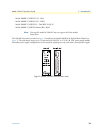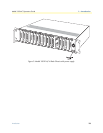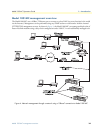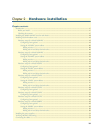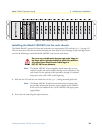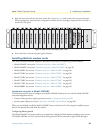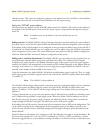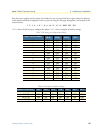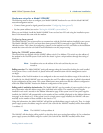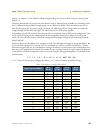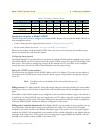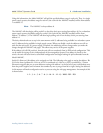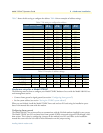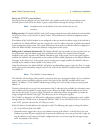
Installing NetLink modem cards 20
Model 1001MC Operations Guide 2 • Hardware installation
100-ohm resistor. This is done by configuring a jumper on the modem’s rear I/O card. Refer to the installation
manual that came with the rack card for more information on this jumper setting.
Setting the 1092ARC system address
The manual that was shipped with the 1092ARC defines switch S2 as Address. This switch sets the address of
the modem in the NetLink system. Each card in the chassis is given a unique address through the setting of
switch S2.
Note Standalone units use the address of the rack card that they are con-
nected to.
Polling overview. The Model 1001MC sends poll messages along the internal bus looking for cards installed in
the system. Once a card is found it is placed online and communication with the management station can begin.
If the address of the NetLink modem is not configured or does not match the address range of the rack that it
is installed in, the Model 1001MC may not recognize the card. The address range that is polled is determined
by the configuration of the system. The system administrator must make sure that the software configuration
within the Model 1001MC matches the hardware configuration of the system.
Polling rack #1 and daisy-chained racks. The Model 1001MC uses the number of power supplies in the sys-
tem to determine what the address range of the individual racks will be. The number of power supplies
installed in each rack is entered on the Modem Information page. If the system is set for two power supplies
installed, the 1001MC will automatically set the number of slots available (displayed on the Modem Informa-
tion page) in the chassis to 13. If the system is set for a single power supply installed, the 1001MC will auto-
matically set the number of slots available in the chassis to 15.
Using this information, the Model 1001MC will poll the specified address range in each rack. Thus, in a single
power supply system, the address range for rack #1 (the rack with the 1001MC installed) will be from address
1 to address 15
Note The 1001MC is always address 0.
The 1001MC will then begin polling rack #2 on the daisy chain port starting from address 16. In a redundant
power supply system, the address range for rack #1 (the rack with the 1001MC installed) will be from
address 1 to address 13. The 1001MC will then begin polling rack #2 on the daisy chain port starting from
address 14.
The daisy chained racks are set up in the same manner with 13 addresses being available in a redundant system
and 15 addresses being available in single supply system. When you disable a rack the addresses are still set
aside for that rack space. If a power supply is removed, the addressing will not change unless you make the
change through the 1001MC web pages. This allows easy service of the power supplies.
If the address is 0 (all ON position), then the unit will run completely from its DIP-switch configuration. This
can be useful for testing circuits independently of the management system. If an address is placed on the
switch, the unit will boot from its stored flash configuration and begin looking for poll commands from the
Model 1001MC.
Switch S2 allows an 8 bit address to be assigned to a link. The following rules apply to setting the address. Bit
S2-8 is the least significant bit. A bit set to ON is considered a 0. A bit set to OFF is considered a 1. Patton
Electronics suggests that you set your addresses starting with address 1 at the far left of your rack (farthest away



